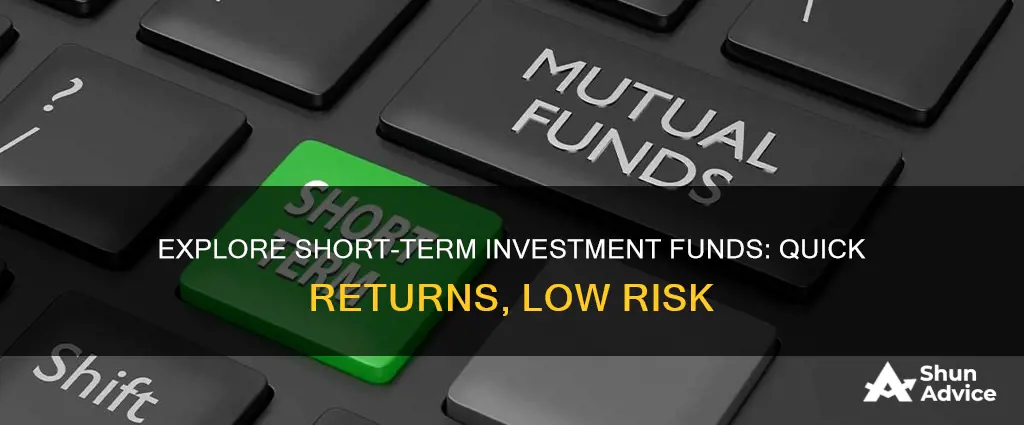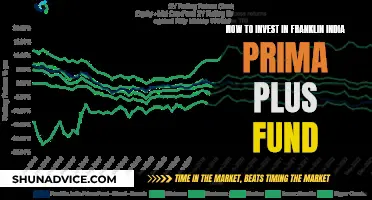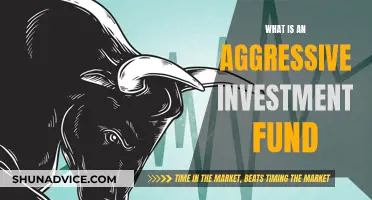
Short-term investment funds (STIFs) are a type of conservative investment strategy, typically investing in low-risk, high-quality, short-term money market investments. STIFs are often highly liquid, allowing investors to access their money quickly and easily. They are considered a safe option for those who need to access their money within a short time frame, such as within three to five years. While STIFs may not offer the same high returns as long-term investments, they provide a stable and consistent option for investors. These funds are usually constructed with a focus on high credit quality, low risk, and liquidity, making them an attractive choice for conservative investors.
Characteristics of Short-Term Investment Funds
| Characteristics | Values |
|---|---|
| Type of Investment | Conservative, liquid, low-risk, low-volatility |
| Returns | Marginally higher than savings accounts |
| Investment Horizon | 1-5 years |
| Investment Instruments | Cash, bank notes, government bills, corporate bonds, mortgage-backed securities, municipal bonds, etc. |
| Risk | Low |
| Liquidity | High |
| Transaction Costs | Low |
| Management Fees | Minimal |
What You'll Learn

Money market funds
There are several types of money market funds, including:
- Government money market funds: These funds are limited to government securities, such as U.S. Treasuries, and collateralized repos involving Treasuries.
- Municipal money market funds: These funds are often called tax-exempt funds because interest on municipal securities is generally exempt from federal income tax.
- Prime money market funds: Prime money market funds are also called general-purpose money markets because assets can be invested in any of the security types.
Planning Mutual Fund Investments: A Guide to Success
You may want to see also

Ultra-short-term bond funds
Compared to other investments, such as money market funds and certificates of deposit (CDs), ultra-short-term bond funds generally carry higher risks. Money market funds, for instance, can only invest in specific high-quality, short-term investments, whereas ultra-short-term bond funds have more flexibility in their investment strategies. Additionally, money market funds aim to maintain a stable net asset value (NAV) of $1.00 per share, unlike ultra-short-term bond funds, whose NAV fluctuates.
When considering investing in ultra-short-term bond funds, it is crucial to understand the associated risks. These funds can vary in their level of risk, and investors should carefully evaluate the types of securities in which the fund invests. For example, investing in bonds with lower credit ratings or derivative securities can expose investors to higher levels of risk. Additionally, longer maturity dates and higher sensitivity to interest rate changes can increase the risk associated with these funds.
In summary, ultra-short-term bond funds offer investors a diverse range of investment options and the potential for higher yields. However, it is important to carefully consider the risks involved, as these funds are not federally insured and can fluctuate in value. Investors should conduct thorough research and understand the specific characteristics of the fund before making any investment decisions.
Merrill Lynch Funds: A Guide to Investing Wisely
You may want to see also

High-yield savings accounts
The best high-yield savings accounts have annual percentage yields (APYs) that are significantly higher than the national average rate. For example, the national average rate is currently 0.45%, while some high-yield savings accounts offer APYs of 5% or more.
When choosing a high-yield savings account, consider the APY, fees, minimum deposit and balance requirements, and how easy it is to access your money. Some accounts may offer ATM cards and refund ATM fees, while others may have higher APYs but require a higher minimum balance.
Pros:
- Higher rates of return on your deposits compared to traditional savings accounts.
- Safer than stocks, bonds, ETFs, and other investments exposed to market risk.
- The money is federally insured, just like in regular checking and savings accounts.
- No minimum deposit or monthly fee requirements for some accounts.
- Some accounts offer optional access to an ATM card.
Cons:
- Interest rates are variable and can change at any time.
- May not be ideal for long-term wealth generation due to inflation.
- Some accounts have minimum balance requirements or caps on the highest APY.
- Limits on the number of withdrawals or transfers per statement cycle.
- Most high-yield savings accounts are offered by online-only financial institutions, which may be a drawback if you prefer in-person banking.
Overall, high-yield savings accounts are a great option for those seeking a safe, short-term investment with higher returns than traditional savings accounts. Be sure to compare different accounts to find one that best suits your needs.
Borrowing to Invest: Risky Real Estate Mutual Funds
You may want to see also

Short-term corporate bond funds
Short-term investment funds are those that you make for less than three years. Short-term corporate bond funds are one such option. These funds are considered safe and pay interest at regular intervals, perhaps quarterly or twice a year. They are good for investors who want a diversified portfolio of bonds without having to analyse individual bonds. They are also good for individual investors who don't have enough money to buy individual bonds.
Bond funds are collections of corporate bonds from many different companies, usually across various industries and company sizes. This diversification means that a poorly performing bond won't hurt the overall return very much. The fund will pay interest on a regular basis, typically monthly.
A short-term corporate bond fund is highly liquid and can be bought and sold on any day that the financial markets are open. You can purchase them at virtually any online broker that offers ETF and mutual funds.
- SPDR Portfolio Short-Term Corporate Bond ETF
- IShares 1-5 Year Investment Grade Corporate Bond ETF
- Schwab 1-5 Year Corporate Bond ETF
- Vanguard Short-Term Bond ETF
- Fidelity Short-Term Bond Fund
Understanding Investment Funds Securities: Risks and Rewards
You may want to see also

Short-term US government bond funds
Short-term investment funds are a type of conservative investment that offers high liquidity and low risk. They are often used as a temporary holding place for investors who plan to move their money to other investments, such as stocks or mutual funds. These funds typically include cash, bank notes, government bills, and conservative bond holdings.
US government bond funds are backed by the full faith and credit of the US government, which means that they are regarded as highly safe investments. The government guarantees the timely repayment of the principal and interest on these bonds. While they offer a reliable rate of interest, the returns are typically lower than those of corporate bonds due to their safety.
Some examples of short-term US government bond funds include the Fidelity® Short-Term Treasury Bond Index Fund and the Vanguard Treasury and Government bond funds.
Mutual Funds: Invest Now or Later?
You may want to see also
Frequently asked questions
Short-term investment funds (STIF) are a type of investment fund that focuses on short-term money market investments, typically with a maturity of less than a year up to five years. They are considered low-risk and highly liquid, offering higher returns than savings accounts.
Some examples of short-term investment funds include money market funds, ultra-short-term bond funds, and short-term bond funds. Money market funds can be further divided into prime, government, and tax-free funds.
Short-term investment funds are suitable for investors seeking a conservative, low-risk investment option with high liquidity. They are often used as a temporary holding place for money before it is deployed to other investments such as stocks or mutual funds.







